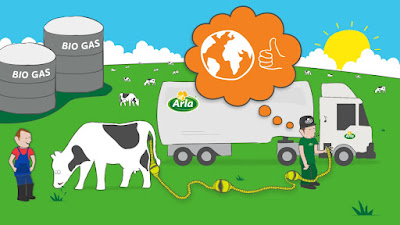With two cows, you make enough bio-gas for your needs
Bio-gas is a by-product of anaerobic (without oxygen) breakdown of organic matter like animal manure and crop waste.These materials are readily available on the farm since most Kenyans engage in farming, particularly in rural areas.
Other waste can come from dairies, brewing, distilleries, vegetable oil refining and slaughterhouses.
 |
| Biogas from cow dung |
The anaerobic digester will partially convert the organic matter into energy in the form of biogas.
The main and most important component is methane, a flammable gas. Others include carbon dioxide and minor gases like hydrogen, nitrogen, and traces of water vapour and hydrogen sulphide.
Bio-gas is generally a clean and environmental friendly renewable fuel, which can be used to run engines like chaff-cutters, generation of electricity, for cooking and heating hot water systems and even refrigeration. Certainly, bio-gas is an alternative solution to the current energy crisis.
The energy content of the gas is directly related to methane gas concentration, where a typical cubic meter of methane gas has a calorific value of about 20 mega joules (MJ) per m3 and burns with 60 percent efficiency on the conventional bio-gas stove.
This in turn implies that a household that uses two burners for cooking for about three hours daily will use approximately 2.7m3 of biogas per day, assuming a single bio-gas burner uses maximum of 0.45m3 of bio-gas per hour.
Usually, a biogas lamp uses approximately 0.15m3 per hour. Therefore, if the same household uses three gas lamps for three hours daily, it will require approximately 1.35m3 of bio-gas per day.
This gives a total of 4.05m3 for cooking and lighting activities. When using the 12m3 bio-gas system, 4.3m3 of bio-gas will be produced per day.
The household will, therefore, have a surplus of 0.25m3 for other purposes or give allowance for non-optimal performance, if any. Most families pay between Sh1,200-Sh1,500 electricity bill per month for lighting only. Majority of bio-gas constructors charge not more than Sh150,000 to put up a 12m3 bio-gas system.
If you are paying Sh1,500 per month, you need about Sh18,000 per year to settle your power bills. Therefore, in about seven years, you will exceed the cost of setting up a 12m3 biogas plant.
Remember the plant has an expected useful life of not less than 30 years. Currently, most of biogas producers rely on cows for manure. The question most people ask is how many cows they need to produce bio-gas.
For the 12m3 we based our calculations on, you need about six cows. However, for the smallest biogas capacity of 4m3, two cows are enough to produce bio-gas that you can comfortably use at home for cooking or lighting.
To set up a bio-gas system, go for a qualified digester designer, builder or equipment supplier. Besides financial capability, manure-power consumption rate determines the size of bio-gas, and, therefore, what one can invest.
The qualified designer should guide you the costs determined by principle components such as foundation, digester effluent storage, roof, gas pump, boiler, hydra-ram manure pump with hydraulic unit, supplies and labour.
The costs also vary depending on local prices and the choice of components one chooses to include in the system.
A well-constructed biogas should be user friendly and sensitive to the safety of workers and visitors around the system.
Areas of concern to owners during production and handling of bio-gas include gas releases that are flammable, liquid tanks that may result in drowning, children and unaware visitors who come close to areas of danger.
Tags:
Dairy Farming
